 Philosopher Jeremy Bentham, father of utilitarianism, relentless advocate for social and political reforms from public education to animal rights to the rehabilitation of prisoners to women’s suffrage, wanted his body to be of use to humanity after he had finished with it. In keeping with what would become the key principle of his philosophical viewpoint, “the greatest happiness of the greatest number that is the measure of right and wrong,” he decided that his dead body should be employed for the public good 63 years before he vacated it.
Philosopher Jeremy Bentham, father of utilitarianism, relentless advocate for social and political reforms from public education to animal rights to the rehabilitation of prisoners to women’s suffrage, wanted his body to be of use to humanity after he had finished with it. In keeping with what would become the key principle of his philosophical viewpoint, “the greatest happiness of the greatest number that is the measure of right and wrong,” he decided that his dead body should be employed for the public good 63 years before he vacated it.
It was 1769 and Bentham, then just 21 years old, included a codicil in his will that his body be left to his friend and kinsman physician George Fordyce for dissection and preservation. He explained his reasoning in that document:
“This my will and special request I make, not out of affectation of singularity, but to the intent and with the desire that mankind may reap some small benefit in and by my decease, having hitherto had small opportunities to contribute thereto while living.”
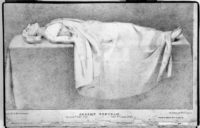 The public dissection aspect was a challenge to the widely-held revulsion at the idea of cutting up a human body even though the surgical profession was then growing by leaps and bounds from it barber-chair origins and the proliferating medical schools were desperate for anatomical specimens. Bentham’s position was typically utilitarian: why, he reasoned, should corpses not be converted from potential sources of anti-social evils (the spread of disease, overcrowded burial grounds, the financial strain of funeral and interral driving the poor into debt, prison, penury) into sources of great benefit to society? And what greater utility could a dead person provide than to give anatomists the opportunity to learn and teach life-saving skills? Instead of being a societal pathogen, the cadaver would be an instrument of healing, a role only it could play.
The public dissection aspect was a challenge to the widely-held revulsion at the idea of cutting up a human body even though the surgical profession was then growing by leaps and bounds from it barber-chair origins and the proliferating medical schools were desperate for anatomical specimens. Bentham’s position was typically utilitarian: why, he reasoned, should corpses not be converted from potential sources of anti-social evils (the spread of disease, overcrowded burial grounds, the financial strain of funeral and interral driving the poor into debt, prison, penury) into sources of great benefit to society? And what greater utility could a dead person provide than to give anatomists the opportunity to learn and teach life-saving skills? Instead of being a societal pathogen, the cadaver would be an instrument of healing, a role only it could play.
But there was another instruction Bentham had for his body after death. He wanted his head to be preserved by such means as to ensure that his looks remained fundamentally unchanged, and joined to his skeletal remains in a tableau he called an Auto-Icon. He would become his own statue, he noted with delight, so there would be no need for marble effigies and solemn funerary monuments.
Two months before his death he reaffirmed this long-held position attaching a memorandum to his latest will that left his body, the duty of public dissection and creation of the auto-icon to his good friend and disciple in utilitarianism Thomas Southwood Smith.
I direct that as soon as it appears to any one that my life is at an end my executor or any other person by whom on the opening of this paper the contents thereof shall have been observed shall send an express with information of my decease to Doctor Southwood Smith requesting him to repair to the place where my body is lying and after ascertaining by appropriate experiment that no life remains it is my request that he will take my body under his charge and take the requisite and appropriate measures for the disposal and preservation of the several parts of my bodily frame in the manner expressed in the paper annexed to this my will and at the top of which I have written ‘Auto-Icon.’
The skeleton he will cause to be put together in such manner as that the whole figure may be seated in a Chair usually occupied by me when living in the attitude in which I am sitting when engaged in thought in the course of the time employed in writing I direct that the body thus prepared shall be transferred to my executor He will cause the skeleton to be clad in one of the suits of black occasionally worn by me. The Body so clothed together with the chair and the staff in my later years borne by me he will take charge of And for containing the whole apparatus he will cause to be prepared an appropriate box or case and will cause to be engraved in conspicuous characters on a plate to be affixed thereon and also on the labels on the glass cases in which the preparations of the soft parts of my body shall be contained as for example as in the manner used in the case of wine decanters my name at length with the letters ob. followed by the day of my decease.
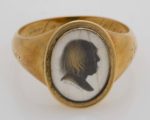 Three days after Bentham’s death on June 6th, 1832, Dr. Smith followed his mentor’s instructions to the letter. Scholars, doctors, men of letters and other luminaries were invited to the dissection held at the Webb Street School of Anatomy and Medicine. Again as instructed by Bentham, Smith delivered a lecture “on the Usefulness of Knowledge of this kind to the Community” over the dead body before proceeding with the dissection.
Three days after Bentham’s death on June 6th, 1832, Dr. Smith followed his mentor’s instructions to the letter. Scholars, doctors, men of letters and other luminaries were invited to the dissection held at the Webb Street School of Anatomy and Medicine. Again as instructed by Bentham, Smith delivered a lecture “on the Usefulness of Knowledge of this kind to the Community” over the dead body before proceeding with the dissection.
Once the anatomical demonstration was over, he went ahead with the auto-icon preparations. He made a skeleton of the bones of Bentham’s body. The philosopher’s head was preserved by putting it over sulphuric acid in a sealed cabinet. An air pump circulated the fumes, drawing out the fluids and drying the head completely, just as Bentham had discussed in his Auto-Icon memo. What Bentham hadn’t planned for was that his head came out looking like the Cryptkeeper’s long-lost twin. A little color adjustment was not going to be able to fix that.
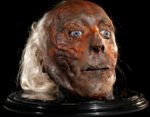 Smith saw that putting so ghastly and unrecognizable a head on top of the stuffed and dressed skeleton would not be in keeping with Bentham’s intent, so he commissioned a wax model of Jeremy’s head from Jacques Talrich, a French artist who created a realistic impression using an 1828 bust, a portrait painted from life by Henry Pickersgill and Southwood Smith’s own memorial ring, one of 24 Bentham had made before his death bearing his profile and a few strands of hair that he willed to his closest friends. Some of Bentham’s hair from his Cryptkeeper head was embedded in the avuncular and warm Ben Franklin-esque wax head.
Smith saw that putting so ghastly and unrecognizable a head on top of the stuffed and dressed skeleton would not be in keeping with Bentham’s intent, so he commissioned a wax model of Jeremy’s head from Jacques Talrich, a French artist who created a realistic impression using an 1828 bust, a portrait painted from life by Henry Pickersgill and Southwood Smith’s own memorial ring, one of 24 Bentham had made before his death bearing his profile and a few strands of hair that he willed to his closest friends. Some of Bentham’s hair from his Cryptkeeper head was embedded in the avuncular and warm Ben Franklin-esque wax head.
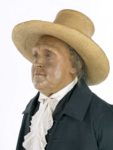 Continuing to pay scrupulous attention to Betham’s instructions, Smith created the auto-icon. The skeleton was stuffed and dressed, topped with the realistic wax head and put in Jeremy Bentham’s preferred chair. In one hand he held his favorite walking stick, Dapple. The whole set piece when then placed in a mahogany and glass display case. Southwood Smith kept the whole shebang in his New Broad Street home until he moved to a smaller place in 1850 and had no room in which to keep his friend’s mounted remains. He arranged to donate it to the University College London (UCL) which holds Jeremy Bentham as a spiritual founding father because so many of the co-founders were his followers.
Continuing to pay scrupulous attention to Betham’s instructions, Smith created the auto-icon. The skeleton was stuffed and dressed, topped with the realistic wax head and put in Jeremy Bentham’s preferred chair. In one hand he held his favorite walking stick, Dapple. The whole set piece when then placed in a mahogany and glass display case. Southwood Smith kept the whole shebang in his New Broad Street home until he moved to a smaller place in 1850 and had no room in which to keep his friend’s mounted remains. He arranged to donate it to the University College London (UCL) which holds Jeremy Bentham as a spiritual founding father because so many of the co-founders were his followers.
Now the UCL had this remarkable effigy and relic of its philosophical role model and had no idea what to do with it. Putting him on open display seemed … awkward. Locking it up … rude? So they stuck the auto-icon in a back room and took people to see him by enquiry only. Dr. Smith wrote to a friend that “the authorities seem to be afraid or ashamed to own their possession.”
Smith was right. Bentham’s auto-icon was all but forgotten until it was rediscovered in the university’s anatomical museum in 1898 by Professor George Thane and curator T. W. P. Lawrence. They described their examination in this freaking amazing report. Seriously one of the greatest all-time reports. (I realize now I totally should have saved this story for Halloween.)
January 3, 1898
We opened the case containing the figure of Jeremy Bentham, and took out the latter. It was rather dusty, but not very much so. The clothes were much moth eaten, especially the undervest, and if taken off it would probably have been impossible to get the last on again. We undid the clothes, and found that they were stuffed with hay and tow, around the skeleton, which had been macerated and skilfully articulated. Both hands are present inside the gloves -the feet were not examined.
In place of the head is a wax bust, which is supported on an iron spike. The head was found, wrapped in cloth saturated with some bituminous or tarry substance (a sort of tarpaulin) and then in paper, making a parcel, in the cavity of the trunk-skeleton, being fastened by strong wire running from the ribs to the vertebral column. On unpacking this the head itself was found to be mummified, dried, and prepared, by clearing any suboccipital soft parts, so that it looks not unlike a New Zealand head. In the sockets are glass eyes. The atlas, which had been macerated, is fastened in its natural place below the occipital bone. At the top of the head is a small hole in the skull, where the tip of the spike had doubtless come through, and round the hole is an impression formed by a circular washer and nut which had fitted the screw on the end of the spike, and by which the head was formerly fixed on the trunk.
The face is clean shaved-hair scanty, grey and long.
(Signed) T. W. P. LAWRENCE and G. D. T.
Yes, Southwood Smith stashed Jeremy Bentham’s mummified head inside his skeleton’s chest cavity. Is that not the greatest real-life Washington Irving story you’ve ever heard? So practical too! I’m sure Bentham would have been delighted to have his rib cage serve as a handy storage compartment for his head.
Anyway, the auto-icon stayed in the anatomy museum for the next few decades before passing into the possession of the UCL library in 1926. The mummified head became part of the display. It was placed on a platter between the auto-icon’s feet, oddly enough. It would be another 13 years before Jeremy Bentham’s auto-icon finally got a thorough restoration, and by then it was 1939 and London was getting to be a very dangerous place. He was moved to two different locations for his safety after the war broke out, only returning to UCL after it was over.
![]() The head was removed from its peculiar position on the floor of the cabinet between the effigy’s feet before World War II, nobody is sure exactly when. It was placed in a display case of its own on top of the auto-icon cabinet, only returning to its former surroundings for the length of a photo session in 1948. It hasn’t been publicly displayed since then and only recently has it begun to receive the punctilious conservation attention it needs. So delicate that ambient movement alone can cause hairs to fall out, Jeremy Bentham’s head is now kept locked in a safe under strict security protocols in environmentally-controlled conditions at the university’s Institute of Archaeology. Only rarely are select researchers allowed access.
The head was removed from its peculiar position on the floor of the cabinet between the effigy’s feet before World War II, nobody is sure exactly when. It was placed in a display case of its own on top of the auto-icon cabinet, only returning to its former surroundings for the length of a photo session in 1948. It hasn’t been publicly displayed since then and only recently has it begun to receive the punctilious conservation attention it needs. So delicate that ambient movement alone can cause hairs to fall out, Jeremy Bentham’s head is now kept locked in a safe under strict security protocols in environmentally-controlled conditions at the university’s Institute of Archaeology. Only rarely are select researchers allowed access.
For a few months this fall and winter, however, he’s back and has such wonders to show you.
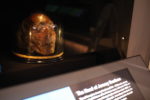 What does it mean to be human? Curating Heads at UCL, which is a pretty great name for an exhibition (although I think it would have been punchier using just the two words: Curating Heads), runs at UCL’s Octagon Gallery from October 2nd, 2017, through February 28th, 2018. Bentham’s remarkable auto-icon is a lens through which visitors can see the changing attitudes towards the display of human remains, the complexity of the issues, the cultural biases and taboos which delimit what human remains are displayed and why. There are events and lectures connected to the exhibition, including one on a favorite topic of mine, extracting and sequencing ancient DNA and what we can learn from it.
What does it mean to be human? Curating Heads at UCL, which is a pretty great name for an exhibition (although I think it would have been punchier using just the two words: Curating Heads), runs at UCL’s Octagon Gallery from October 2nd, 2017, through February 28th, 2018. Bentham’s remarkable auto-icon is a lens through which visitors can see the changing attitudes towards the display of human remains, the complexity of the issues, the cultural biases and taboos which delimit what human remains are displayed and why. There are events and lectures connected to the exhibition, including one on a favorite topic of mine, extracting and sequencing ancient DNA and what we can learn from it.